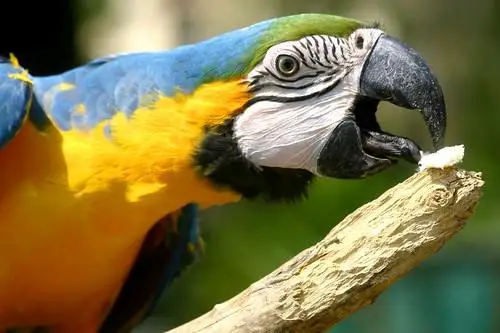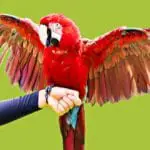If we try to observe at parrots, one of the first things that always caught anyone’s attention is the over-sized that jutting out over from its face. Being a bird lover, it is considered to respect massive and one of the reasons that cause a few people to fear their pet parrots. If you look inside their mouth, apparently, you will see that parrots have no teeth is visible.
Understanding the Oral Cavity of Parrots
Actually, most birds used to have no teeth, but for about 2.5 million years ago, it starts developing. Some bird species such as the geese have notched edges that located in their beaks that look like a toothy appearance, but it is an alteration to their bill that also known as tomia, and it is considered as not all is their genuine teeth.
Here are the good-to-know facts about the oral cavity of parrots:
1. Parrots Don’t Really Need Teeth
Generally, we must say that all our pet parrots do not really require having teeth. Because the parrot is a current-day diet does not really need the teeth. They are already very efficient in desolating our goods without the help of their teeth. You will also notice that parrots are commonly lack of saliva.
2. Parrots Have Salivary Glands
In addition, if you are curious enough to see your parrot’s mouth, you might notice that it looks so dry. However, in reality, there are really salivary glands located at the back of the parrot’s mouth that develops the wetness content that helps in swallowing your pet’s dry food such as seed as well as pellets.

Good to Know Facts About Parrot Tongue
There is a V-shaped slit having trim edges that also known as choana located at the very back mouth of the parrot. In that back mouth of the parrot is the part of the palate that consider as the barrier in between the throat of the bird as well as in the nasal passages.
Intriguing facts, this particular part of the parrot’s mouth provides a lot of information about your parrot pet’s health. Usually, your avian veterinarian will examine the state of the soft barbs that edging the choana for symptoms of dietary shortage and any other issue.
Here are the good-to-know facts about parrot tongue anatomy:
- The most exceptional dweller inside the parrot’s mouth is surely the tongue. Different from a human’s tongue, which totally consists of muscle tissues.
- The parrot’s tongue is consists of a range of bones that also called the hyoid; this is the structure that provides both flexibility and rigidity.
- These bones are attached by fleshy padding, and in place of hands, the parrot usually uses its tongue while it is traveling its surroundings. There is a Y shape-like located into the bone that closest to the parrot’s tip of its tongue that makes a slightly hollow that assists those to keep objects in place in averse to the tip of their tongue while they handle them.
Video Source: Youtube
- It is quite fascinating to observe for a parrot to roll a nut or bead around using its tongue just the same agility of about three fingers of a human. A few current scientific articles issued to interpret the role of a parrot’s tongue that has an ability to imitate human speech. It seems that they have just now seen how energetic a parrot’s tongue is while it’s talking and has conjectured that it can be essential to the procedure that you recently think.
- The parrot’s tongue is usually used to utilize the food that is inside their bill. Even their tongues may sometimes look unremarkable; the parrots are known to be unusual among all birds that having a muscle in their tongue as the humans do. Commonly most numbers of birds don’t have a muscle in the front of their third tongue at all, which is exclusively characterized by parrots.
As a human, can you try to make or pronounce the P or either B sound without moving your lips? This is like monitoring to us, as a parrot owner that construct a very long time before. Keep in mind that the healthy tongue parrot looks like smooth, unblemished, and it is commonly dry. They are also usually color grey, black, or sometimes pink.
The Parrot that Speaks Using Their Tongues

Have you ever thought about what makes a parrot on why they are so good at mimicking human sound? It proves to be the case that the feathered impressionist uses its tongue to make a vowel-like voice just like what humans do. Regarding a human’s speech, the noise usually develops in the part of the larynx, and then it can make alterations to the movement of the tongue in the mouth.
It commonly assists humans in making a compounded vowel as well as consonant sounds. Until recent days, a lot of researchers think that the birds that develop and adjust their song in the counterpart of avian of the larynx, the syrinx, and the parrot’s tongue play no role at all.

Parrots Tongue Imitates Human Speech
But generally, the parrots are known to move up and down their fleshy-like tongues when they are talking. One of the students from Leiden University in the Netherlands, whose name is Gabriel Beckers he decided to observe whether the movement of the bird’s tongue contributes to the birds’ biggest talent of imitating human speech. The result is issued in Current Biology.
They use five feral monk parakeets, also known as Myiopsitta monachus, to observe which they had been captured and they killed as part of the government pest control initiative in the city of Florida. In every bird, they replenish the syrinx with a small electronic speaker. Then, they also used a small hook to at least move the tongue all over as stands as the amplifier that played a burst of sound.
Here are the findings of a parrot tongue when it comes to imitating human speech:
- The tongue gesture of less than a millimeter just made a large distinction to the standard of joining the vowel-like sounds. Gabriel Beckers thinks that the parrot’s capability to handle their tongues is too eloquent the vowel sound that as likely as not underpins their talents as imitators.
- The parrots having a muscular, nimble tongue may assist in describing their supernatural capability to imitate human sounds, other scientists have concluded. The parrots may regulate the sound that comes from their voice box by simply calibrating their tongue. The parrots are the only animals known to do this other than a human.
- The parrots, as well as humans, share the capability to make a standard way of vocalization. The difference between the human vocal tract that filters the sound that they developed by the use of vocal cords that help to qualify speech.
- The vocal expanse highlight standard pitches that called the formants. That is the stuff of the vowels. However, the tongue can be easily changed by the use of altering the sounds and the shape or position.
Conclusion
Now you’re more knowledgeable about the anatomy of the tongue of parrots. It plays a crucial role in eating food and in vocalization that parrots are mostly sought for. The parrot tongue has distinct features only found in parrots. Parrots have muscle in their tongues, which is only present in parrots among the many bird species.


